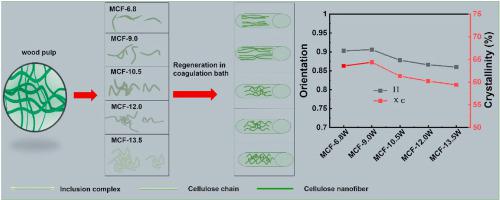Polymer ( IF 4.6 ) Pub Date : 2021-01-06 , DOI: 10.1016/j.polymer.2021.123379 Kang Xie , Hu Tu , Zhengli Dou , Dingyao Liu , Kai Wu , Yuhang Liu , Feng Chen , Lina Zhang , Qiang Fu

|
The low-temperature alkali/urea aqueous system has received wide public attention since it is a better method to reduce pollution by preparing the regenerated cellulose fiber through the green dissolution system. Since molecular weight has a significant impact on the solubility and mechanical property of regenerated cellulose fiber; thus, we designed this experiment that cellulose materials with molecular weight ranging between 6.8 × 104 to 13.5 × 104 were employed for wet-spinning in alkali/urea aqueous system. It is found that as molecular weight of cellulose increases, cellulose solution decreases in solubility but cellulose molecular chain aggregates increase. However, bath the stability and viscosity of cellulose solutions almost remain unchanged with the change of molecular weight. As for the spun fibers, it is found that the orientation and crystallinity are relatively high when the molecular weight is low (6.8 × 104–9 × 104). These are excellent mechanical properties However, unlike conventional polymers, when molecular weight further increases to 9 × 104–13.5 × 104, the degree of orientation and crystallinity gradually decreases. This is due to a large number of entanglements between adjacent molecular chains, thereby hindering the molecular chain orientation along with reduced mechanical property. Our work demonstrates that the considerable molecular weight of cellulose is neither good for dissolution nor spun fibers' mechanical property. The choice of cellulose with relatively low molecular weight is essential not only for the excellent dissolution but also for fiber property.
中文翻译:

纤维素分子量对碱/尿素水体系纺制的再生纤维素纤维内部结构和性能的影响
低温碱/尿素水体系受到广泛关注,因为它是通过绿色溶解系统制备再生纤维素纤维来减少污染的更好方法。由于分子量对再生纤维素纤维的溶解度和机械性能有重大影响;因此,我们设计了该实验,使分子量范围为6.8×10 4至13.5×10 4的纤维素材料用于碱/脲水溶液体系中的湿纺。发现随着纤维素分子量的增加,纤维素溶液的溶解度降低,但是纤维素分子链聚集体增加。然而,随着分子量的变化,浴液中纤维素溶液的稳定性和粘度几乎保持不变。对于纺丝纤维,发现当分子量低时(6.8×10 4 –9×10 4),取向和结晶度相对较高。它们具有优异的机械性能。但是,与常规聚合物不同,当分子量进一步增加至9×10 4 –13.5×10 4时,取向度和结晶度逐渐降低。这是由于相邻分子链之间的大量缠结,从而阻碍了分子链取向以及降低的机械性能。我们的工作表明,相当大的纤维素分子量既不利于溶解,也不利于纺制纤维的机械性能。分子量相对较低的纤维素的选择不仅对于出色的溶解性至关重要,而且对于纤维性能也至关重要。



























 京公网安备 11010802027423号
京公网安备 11010802027423号